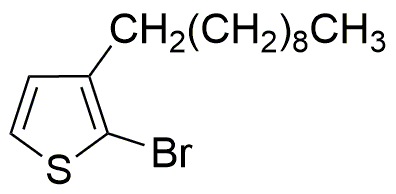2-Bromo-3-decylthiophene is widely utilized in research focused on:
- Organic Electronics: This compound serves as a key building block in the synthesis of organic semiconductors, which are essential for developing flexible and lightweight electronic devices like OLEDs and solar cells.
- Photovoltaic Applications: Its unique properties enhance the efficiency of organic photovoltaic cells, making it a valuable component in renewable energy technologies aimed at improving solar energy conversion.
- Conductive Polymers: Used in the production of conductive polymers, it contributes to the development of materials that can be used in sensors and electronic components, providing better conductivity compared to traditional materials.
- Research in Material Science: This compound is instrumental in studying the properties of thiophene derivatives, helping researchers explore new materials for various applications, including coatings and adhesives.
- Advanced Coatings: Its application in formulating advanced coatings offers benefits such as improved durability and resistance to environmental factors, making it suitable for protective coatings in industrial settings.
General Information
Properties
Safety and Regulations
Applications
2-Bromo-3-decylthiophene is widely utilized in research focused on:
- Organic Electronics: This compound serves as a key building block in the synthesis of organic semiconductors, which are essential for developing flexible and lightweight electronic devices like OLEDs and solar cells.
- Photovoltaic Applications: Its unique properties enhance the efficiency of organic photovoltaic cells, making it a valuable component in renewable energy technologies aimed at improving solar energy conversion.
- Conductive Polymers: Used in the production of conductive polymers, it contributes to the development of materials that can be used in sensors and electronic components, providing better conductivity compared to traditional materials.
- Research in Material Science: This compound is instrumental in studying the properties of thiophene derivatives, helping researchers explore new materials for various applications, including coatings and adhesives.
- Advanced Coatings: Its application in formulating advanced coatings offers benefits such as improved durability and resistance to environmental factors, making it suitable for protective coatings in industrial settings.
Documents
Safety Data Sheets (SDS)
The SDS provides comprehensive safety information on handling, storage, and disposal of the product.
Product Specification (PS)
The PS provides a comprehensive breakdown of the product’s properties, including chemical composition, physical state, purity, and storage requirements. It also details acceptable quality ranges and the product's intended applications.
Certificates of Analysis (COA)
Search for Certificates of Analysis (COA) by entering the products Lot Number. Lot and Batch Numbers can be found on a product’s label following the words ‘Lot’ or ‘Batch’.
Numéro de catalogue
Numéro de lot/série
Certificates Of Origin (COO)
This COO confirms the country where the product was manufactured, and also details the materials and components used in it and whether it is derived from natural, synthetic, or other specific sources. This certificate may be required for customs, trade, and regulatory compliance.
Numéro de catalogue
Numéro de lot/série
Safety Data Sheets (SDS)
The SDS provides comprehensive safety information on handling, storage, and disposal of the product.
DownloadProduct Specification (PS)
The PS provides a comprehensive breakdown of the product’s properties, including chemical composition, physical state, purity, and storage requirements. It also details acceptable quality ranges and the product's intended applications.
DownloadCertificates of Analysis (COA)
Search for Certificates of Analysis (COA) by entering the products Lot Number. Lot and Batch Numbers can be found on a product’s label following the words ‘Lot’ or ‘Batch’.
Numéro de catalogue
Numéro de lot/série
Certificates Of Origin (COO)
This COO confirms the country where the product was manufactured, and also details the materials and components used in it and whether it is derived from natural, synthetic, or other specific sources. This certificate may be required for customs, trade, and regulatory compliance.


